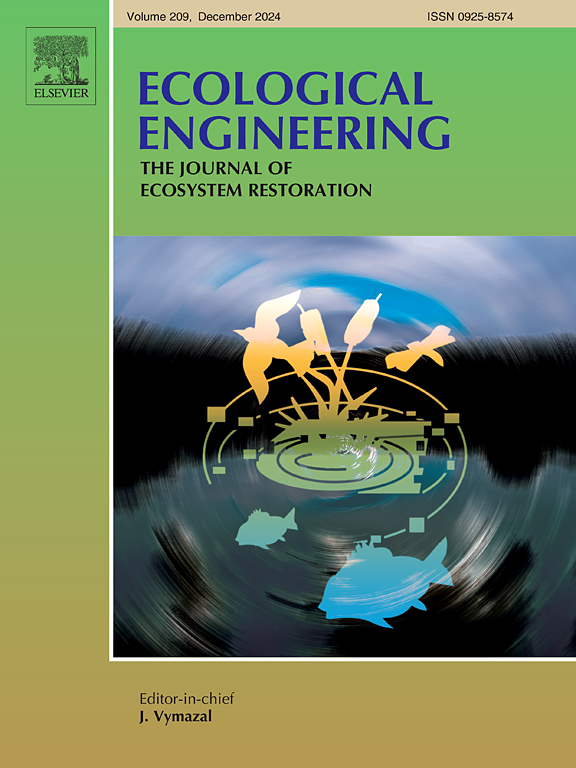干旱环境下长期管理措施对土壤酶活性和微生物养分动态的影响——以塔克拉玛干沙漠南部为例
IF 3.9
2区 环境科学与生态学
Q1 ECOLOGY
引用次数: 0
摘要
土壤酶活性对于显示土壤微生物养分需求和限制非常重要。然而,我们对干旱环境中生态酶的化学计量和微生物养分吸收的了解还很有限。这项研究在塔克拉玛干沙漠南部边界进行,考察了不同长期管理措施下的土壤养分水平、微生物生物量和酶活性,包括对照组(CK)、春季砍伐组(CS)、秋季砍伐组(CF)、春季焚烧组(BS)和洪水灌溉组(FI)。研究结果表明,与 FI 相比,CS 使土壤有机碳 (SOC) 和可利用钾 (AK) 显著增加。此外,采用各种管理措施(CK、CS、CF、BS 和 FI)的土壤表现出高度的氮限制。在 CK,土壤微生物氮代谢与微生物碳代谢同时增加。在 CS 中,土壤可利用磷(AP)和全钾(TK)对土壤微生物生物量、酶活性、微生物碳和氮代谢的影响显著,贡献率分别为 4.65 % 和 1.91 %。在 CK 方面,土壤中的可利用氮(AN)对土壤微生物生物量、酶活性和微生物碳氮代谢具有重要作用,贡献率为 5.92%。在 BS 中,土壤全氮(TN)、SOC 和 pH 对土壤微生物生物量、酶活性和微生物碳氮代谢有显著影响,分别占 7.16 %、6.70 % 和 1.62 %。在 FI 中,土壤 TN 和 SOC 对土壤微生物生物量、酶活性和微生物碳氮代谢的贡献率分别为 7.16 % 和 6.70 %。在 CK,土壤 AN:AP 与土壤亮氨酸氨肽酶(LAP)呈显著负相关。在 CS 和 BS 中,土壤 TC:TP(土壤有机碳与全磷比)和 TN:TP 与土壤 β-1,4-葡萄糖苷酶(BG)呈显著正相关,反之,土壤 TC:TN 与土壤 β-D-纤维生物酶(CBH)呈显著负相关。结构方程模型表明,土壤 AN:AP、土壤 TC:TN:TP 与土壤酶活性呈负相关。这项研究强调了采用可持续管理策略保护和恢复土壤功能的重要性,从而提高高度干旱地区生态系统的整体健康水平和恢复能力。本文章由计算机程序翻译,如有差异,请以英文原文为准。

Effects of long-term management measures on soil enzyme activity and microbial nutrient dynamics in an arid environment: A case study from the Southern Taklimakan Desert
Soil enzyme activity is important for indicating soil microbial nutrient demand and limitation. Yet, our knowledge of eco-enzymatic stoichiometry and microbial nutrient uptake in arid environments is restricted. This research, conducted at the southern boundary of the Taklimakan Desert, involved an examination of the soil's nutrient levels, microbial biomass, and enzymatic activities under different long-term management measures, including the control group (CK), cutting in spring (CS), cutting in fall (CF), burning in spring (BS), and floodwater irrigation (FI). The results of the research show that the use of CS led to a notable rise in soil organic carbon (SOC) and available potassium (AK) in comparison to FI. Additionally, the soils subjected to various management measures (CK, CS, CF, BS, and FI) exhibited a high level of nitrogen limitation. In CK, soil microbial nitrogen metabolism increased along with microbial carbon metabolism. In CS, the impact of soil available phosphorus (AP) and total potassium (TK) on soil microbial biomass, enzyme activity, and microbial carbon and nitrogen metabolism was significant, with a respective contribution of 4.65 % and 1.91 %. In the context of CK, the available nitrogen (AN) in the soil played a significant role in soil microbial biomass, enzyme activity, and microbial carbon and nitrogen metabolism, contributing 5.92 %. Within the BS, soil total nitrogen (TN), SOC, and pH exerted significant influences on soil microbial biomass, enzyme activity, and microbial carbon and nitrogen metabolism, contributing 7.16 %, 6.70 %, and 1.62 % respectively. Within the context of FI, soil TN and SOC contributed to 7.16 % and 6.70 % of soil microbial biomass, enzyme activity, and microbial carbon and nitrogen metabolism. In CK, soil AN: AP was significantly negatively correlated with soil leucine aminopeptidase (LAP). In CS and BS, soil TC:TP (soil organic carbon and total phosphorus ratio) and TN:TP was significantly positively correlated with soil β-1,4-glucosidase (BG), inversely, soil TC:TN was significantly negatively correlated with soil β-D-cellobiosidase (CBH). Structural equation model indicated that soil AN: AP, soil TC:TN:TP were negatively correlated with soil enzyme activity. This study emphasizes the importance of adopting sustainable management strategies to safeguard and rehabilitate soil functionality, thereby enhancing the overall health and resilience of ecosystems in highly arid regions.
求助全文
通过发布文献求助,成功后即可免费获取论文全文。
去求助
来源期刊

Ecological Engineering
环境科学-工程:环境
CiteScore
8.00
自引率
5.30%
发文量
293
审稿时长
57 days
期刊介绍:
Ecological engineering has been defined as the design of ecosystems for the mutual benefit of humans and nature. The journal is meant for ecologists who, because of their research interests or occupation, are involved in designing, monitoring, or restoring ecosystems, and can serve as a bridge between ecologists and engineers.
Specific topics covered in the journal include: habitat reconstruction; ecotechnology; synthetic ecology; bioengineering; restoration ecology; ecology conservation; ecosystem rehabilitation; stream and river restoration; reclamation ecology; non-renewable resource conservation. Descriptions of specific applications of ecological engineering are acceptable only when situated within context of adding novelty to current research and emphasizing ecosystem restoration. We do not accept purely descriptive reports on ecosystem structures (such as vegetation surveys), purely physical assessment of materials that can be used for ecological restoration, small-model studies carried out in the laboratory or greenhouse with artificial (waste)water or crop studies, or case studies on conventional wastewater treatment and eutrophication that do not offer an ecosystem restoration approach within the paper.
 求助内容:
求助内容: 应助结果提醒方式:
应助结果提醒方式:


